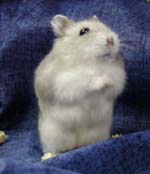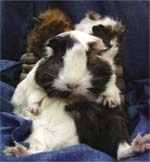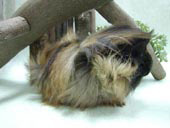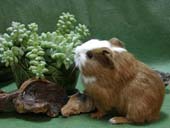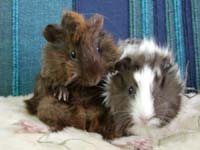GUINEA PIG

Am I the right pet for you?
Guinea pigs make ideal children's pets. They are sometimes nervous but rarely bite or scratch when handled. They are inquisitive and friendly, like to be handled and are very talkative!

Where did I come from?
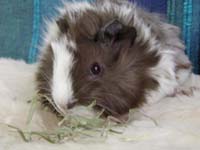
Guinea Pigs originated from the Andes Mountains region of South America. In
their natural habitat, guinea pigs live wild in the forests and grassy areas.
They were probably first domesticated by the Indian of Peru, who used them for
food and as sacrificial offerings to their gods. In 16th century Dutch explorers
introduced them to Europe. And they have been kept as pets in Europe for at
least four hundred years.
Guinea Pigs are one of the world's most popular pets. They are inexpensive,
undemanding, hardy and sociable creatures. They belong to the rodent group,
which includes animals such as squirrels, hamsters and other gnawing creatures.
Guinea Pigs are very social animals and will get along with other animals,
however, contrary to popular belief it isn't advisable for guinea pigs and
rabbits to live together. This is because guinea pigs and rabbits are very
different animals and require different foods. Rabbits can also be aggressive,
attacking both guinea pigs and even other rabbits.

Where do i like to live?
Guinea Pigs can be kept outdoors all the year round or indoors if you prefer. If
they are outside, the hutch must be draught and weatherproofed and raised off
the ground. A guinea pig hutch should be at least 76 x 38 x 38 cm, with separate
living room and bedroom and wood shavings or chippings on the floor. Hay makes
an excellent bed as well as being good to eat.
Keeping Guinea Pigs indoors would eliminate the need for a hutch but would
require a cage of at least 24" X 14" X 18 ". It is essential to provide a safe
and quite place for them to rest.
If you have space, you can add a run with rocks, logs and earthenware pipes to
play amongst. The run can go straight onto your lawn but should be moved
regularly to prevent overgrazing. There must be shelter from the sun and
draughts.

How to handle me?
Your new guinea pig is likely to be nervous. For the first few days talk to him regularly before introducing your hand into the cage and stroking him. When he is used to this you can pick him up. Use both hands; one under the chest with the guinea pig's front legs either side of your fingers; the other resting on his neck and back. Hold him close to you to prevent him wriggling and falling. Once they are used to you, they will welcome your handling and would actually ask for it but calling out to you. This is a really rewarding moment.

What do I eat?
Fresh Timothy hay from American Pet Diner, a good quality guinea pig pellet from
Mazuri or American Pet Diner is an ideal basic diet for your pet guinea pigs or
cavies.
Add small quantities of fresh vegetables or fruit such as apples, strawberries,
tomatoes, potatoes or freshly picked grass. Never feed food which has been
frozen or frosted and introduce new foods gradually to avoid stomach upsets.
Unlike most animals, guinea pigs (and humans) cannot make their own vitamin C
and you should add a vitamin supplement to their diet. Mazuri Guinea pig pellets
are enriched with stabilized Vit. C (www. mazuri.com) to provide your guinea pig
with they Vit. C they need. Oxbow also has Extra C tablets to supplement. A
mineral stone in the hutch will keep their teeth sharp and provide any extra
nutrients they might need.
Guinea pigs eat little and often and the dry food should be available at all
times. If the bowl is frequently emptied you are probably not giving enough.
Fresh food should be fed in the morning and any that is uneaten removed with in
a few hours.
Heavy earthenware feeding dishes are best as they are difficult to knock over
and fresh water should readily be available, preferably from an inverted bottle.
Feeding bowls and water bottle should be washed daily. It is especially
essential to wash the water bottle daily as guinea pigs are prone to
regurgitating their saliva into the bottle while drinking.
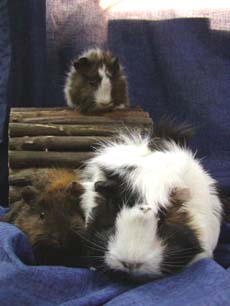

Do I like company?
Guinea pigs are social animals and will be happiest with another guinea pig as company. They are also prolific breeders so unless you are planning a colony, choose two of the same sex.

Keeping me fit and healthy
A healthy guinea pig will be alert with bright eyes, dry nostrils and a clean
and shiny coat. The droppings in the hutch should be small, firm pellets. Signs
of sickness are a dull or dirty coat, loss of appetite, skin sores, loose
droppings or a runny nose. Poor hygiene is a common cause of sickness. Soiled
bedding should be replaced daily and the cage should at least be cleaned
thoroughly with a good quality pet disinfectant once a week.
If your pet looks off colour and you are sure you have followed all the advice
given above, contact your vet immediately.

Breeding
■ Sows can breed from 30 days of age, but should not be put with a boar until
they are 4 months old.
■ The average length of pregnancy in guinea pigs is 60 - 65 days.
■ The average litter is between 3 to 4.
■ The young can be removed from their mother at 3 - 4 weeks.
